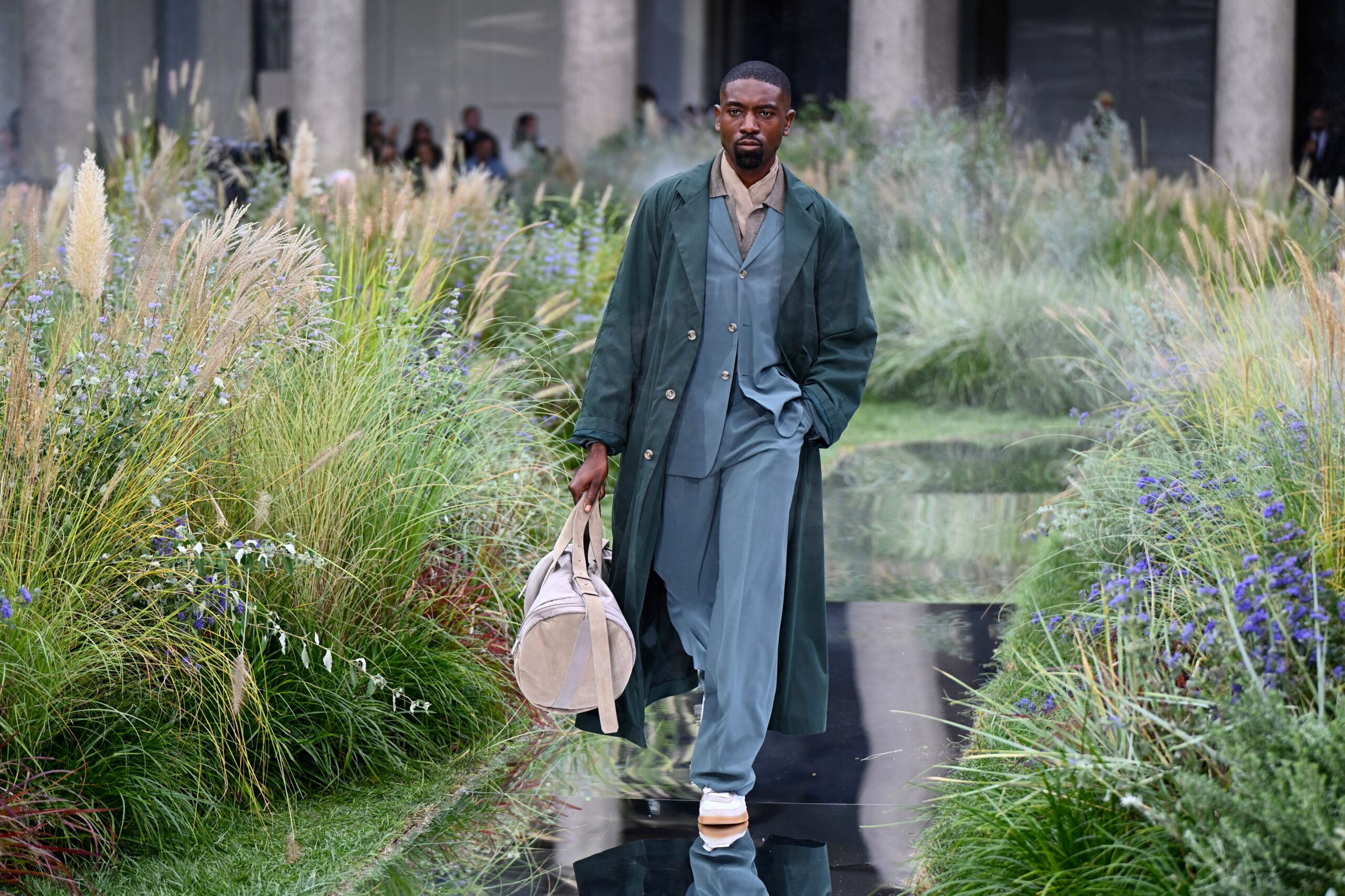The Milan roll call is an impressive one: Prada, Gucci, Dolce & Gabbana and Versace, to name but four. There will be no Giorgio Armani this time, although the designer will still be showing his diffusion line, Emporio Armani.
September 18
Boss goes ‘out of office’
The German suiting specialist Boss is on a winning streak at the moment, its profits up 22 per cent last year to €410 million. This would be impressive at any time yet is particularly so given the twin challenges of the economic climate and the shift towards home working and casual attire.

Boss’s show focused on casual, sportswear-adjacent looks
GABRIEL BOUYS/AFP VIA GETTY IMAGES
This men’s and women’s collection — codename, so said the press release, “out of office” — encapsulated how Boss is pulling off its upward trajectory. The sportswear-adjacent flavour was strong. That was even before one factored in David Beckham, this his debut front row appearance as the brand’s recently announced “strategic partner”, and an assortment of sports stars on the catwalk. The first look was worn by the American tennis player Taylor Fritz, runner-up at the US Open earlier this month.

David Beckham was sitting between Daniel Grieder, Boss’s chief executive, and Anna Wintour, the editor-in-chief of Vogue
GABRIEL BOUYS/AFP VIA GETTY IMAGES
Jackets used to come with ties. Now they come with hoodies and even, in the case of one model, with a yoga mat slung over your back. The potency of a good suit remains undiminished, especially when delivered in a contemporary-looking fabric and cut. Yet, thanks to our collective obsession with youth — and its concomitant suggestion of both vigour and cool — a new variety of flex has been added to the mix.

Taylor Fritz, the American tennis player, maintained the sporty flavour of the Boss show
GABRIEL BOUYS/AFP VIA GETTY IMAGES
Sporty detailing (toggles, zips, elastication and future-facing textiles) now signal that someone is fit for purpose in contexts that have nothing to do with actual fitness. We have silicon valley to thank for that. It was the so-called tech bros such as Mark Zuckerberg who first embraced this approach to power dressing, although they just wore the humdrum sportswear originals and certainly didn’t pair their hoodies with anything as smart as a blazer.
Advertisement

VITTORIO ZUNINO CELOTTO/GETTY IMAGES
Boss showed how to make things more upscale, not to mention more interesting. As well as adding in its signature tailoring, it deployed a clever palette — more diverse, whilst still “safe” — plus contrasting textures and layers.
There was also suiting at Jil Sander, and even some of those aforementioned missing-in-action ties, rendered in the same fabrics as the shirts. In the mix too — and a mix was precisely what it was — were cheongsam silks, ombré satin co-ords and striking screen prints. It was a line-up notable not just for its diversity but its loveliness.

Jil Sander’s show combined striking colours and gorgeous materials
GIOVANNI GIANNONI/GETTY IMAGES

GIOVANNI GIANNONI/GETTY IMAGES
September 17
Fendi unafraid to take inspiration from Virginia Woolf

Fendi’s spring/summer 2025 collection drew inspiration from Virginia Woolf and the Bloomsbury Group
Next year the Rome-based brand Fendi celebrates its centenary. For its spring/summer collection Kim Jones, the British creative director, chose to ring the changes between 1925 and 2025, yet also draw parallels. Backstage before the show he spoke of “wanting to look at the way women began to dress in the 1920s, that new modernity, and to revisit it in a contemporary context”.

LUCA BRUNO/AP
Actually, perhaps this was more a case of squaring the circle, given that Jones’s stated inspiration was Virginia Woolf and the Bloomsbury Group. It was Dorothy Parker who quipped that its members “lived in squares, painted in circles and loved in triangles”. One might add, when it came to the women, “dressed in columns”, as referenced via Jones’s unwaisted frocks and straight up-and-down outerwear (though in reality Woolf et al tended more towards the rather sack-like).

PIETRO D’APRANO/GETTY IMAGES
Handily, when it came to his historical research, the designer was able to draw on his collection of Woolf books and manuscripts, the largest in private hands in the world.
Advertisement
At the same time there was a Fendi-specific flavour to the line-up, with a number of the ensembles inspired by one or other of the five sisters who took over the brand from their parents in the 1970s and transformed it into an international entity. “I would think to myself, ‘This is an Anna look’,” Jones, 51, said.
• London Fashion Week: all the key trends
He added that he had one more muse: a certain Kate Moss, with whom he has been friends for decades. “I love watching Kate getting dressed for dinner when we are on holiday, seeing her try on lots of different outfits.”

PIETRO D’APRANO/GETTY IMAGES
It’s easy to imagine Moss rocking one of his sheer flapper gowns with art deco beading and Louise Brooks fringing. It might — sadly — be a somewhat trickier approach for the rest of us to pull off.
Luckily Jones, once a menswear specialist, cuts a great jacket too, so there was plenty of tailoring to offset all the see-through. He played a game of compare and contrast with the accessories as well, the footwear encompassing delicate nude kitten heels together with chunky boots produced in collaboration with Redwing, the squishy bags ranging from Lilliputian to Brobdingnagian.
Advertisement

PIETRO D’APRANO/GETTY IMAGES
There are rumours that Jones, who simultaneously heads up Dior menswear in Paris, might be returning to a big gig in London. Whatever the truth in that, he’s clearly enjoying himself where he is.
